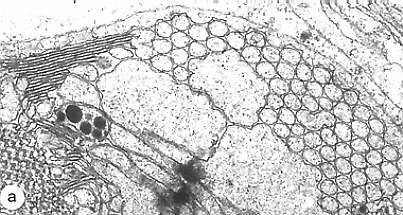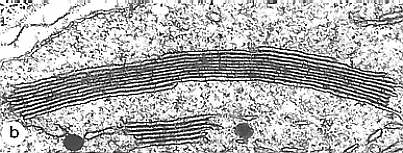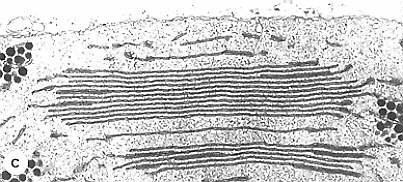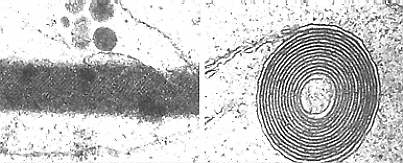 Plastid membranes from seedlings that have been cultivated in
the dark after several hours of light exposure: (a) xantha-
a63: The uncontrolled synthesis of lipids specific for chloroplasts
leads to the formation of membranes arranged like honeycombs together
with prolamellar bodies and grana.
und Grana.
Plastid membranes from seedlings that have been cultivated in
the dark after several hours of light exposure: (a) xantha-
a63: The uncontrolled synthesis of lipids specific for chloroplasts
leads to the formation of membranes arranged like honeycombs together
with prolamellar bodies and grana.
und Grana.
 (b) xantha-d3l: Thylacoids aggregate as giant grana.
(b) xantha-d3l: Thylacoids aggregate as giant grana.
 (c) xantha-f60: Mutants with an inhibited chlorophyll synthesis.
The synthesis is blocked between protoporphyrin IX and Mg-protoporphyrin.
As a consequence is the mutant unable to arrange its thylacoids
as grana.
(c) xantha-f60: Mutants with an inhibited chlorophyll synthesis.
The synthesis is blocked between protoporphyrin IX and Mg-protoporphyrin.
As a consequence is the mutant unable to arrange its thylacoids
as grana.
 (d) tigrina-o34: The mutant has a defect in the regulation
of chlorophyll and carotene synthesis. The accumulation of a higher
saturated carotene, the lycopine, in the plastids of the mutant
causes the formation of abnormally structured grana. e. xantha-b18:
Mutants with a spheroid granum (K. W. HENNINGSEN, J. E. BOYNTON,
O. F. NIELSEN and D. von WETTSTEIN, 1985).
(d) tigrina-o34: The mutant has a defect in the regulation
of chlorophyll and carotene synthesis. The accumulation of a higher
saturated carotene, the lycopine, in the plastids of the mutant
causes the formation of abnormally structured grana. e. xantha-b18:
Mutants with a spheroid granum (K. W. HENNINGSEN, J. E. BOYNTON,
O. F. NIELSEN and D. von WETTSTEIN, 1985).
© Peter v. Sengbusch - b-online@botanik.uni-hamburg.de